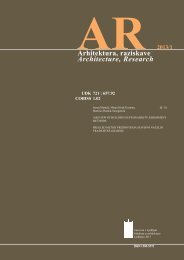Revija 2005/1 v PDF - Fakulteta za arhitekturo - Univerza v Ljubljani
Revija 2005/1 v PDF - Fakulteta za arhitekturo - Univerza v Ljubljani
Revija 2005/1 v PDF - Fakulteta za arhitekturo - Univerza v Ljubljani
You also want an ePaper? Increase the reach of your titles
YUMPU automatically turns print PDFs into web optimized ePapers that Google loves.
2oo5 / 1 ARMan is cultural being, and anthropology researches his essence,intends, work and results.The prime man worked and he developed his thought: in time andin the space. In early time there were more work and less thought,survival was his idea. Then, with brain, he stopped his fears offire: more - he used it for his own purposes (for self-defence, forbaking, for making light, for technology).Architecture is science of design the room for all neededpurposes: living, working, defending, making culture and fun (ifthose are not the same). Architecture has theory and practice.While practice means construction mostly, theory is morecomplicated.It is the question of culture if we understand the prime man andnature, man in the nature, or man in front of nature.In the history, nature had been teaching and the prime manlearned from it. And he survived, in spite of wild animals, whowere stronger and bigger.Very important detail is that all old architecture (man's work, is tomention) we have today, is good architecture, because all badconstructions collapsed in time, hundred or thousand years ago.So: man could learn from old architecture.And he made the first measures by himself: on his brain and on hisbody. His thought developed the culture and aesthetics in theory,his hands developed some skills, for practical use. Both brain andhands developed some methods. Today we hardly believe theyexisted, but they did.The man had been taught by nature with construction, and hecould continue with understanding the sense, Today we wouldsay " typology ".The prime man understood that order is the most important. Orderbetween quanta: in length, room or in cube. And the firstmeasures were built by himself: inch (finger), elbow, foot. Theproblem was that no one foot or elbow were not the same.The second problem was in relation of quanta, lengths mostly.Thousands years before the first theoretic (Pythagoras forinstance) he used " holy triangle " (3, 4, 5, known as " Egyptiantriangle ") and other physical orders, as well as equilateraltriangle, squares etc. Golden section is widely in use in detail as inwhole (Le Corbusier: Modulor and UNO palace in NewYork).Egyptian triangle can be constructed with the help of rope andfour men: composed triangle has right angle.Square root of two is diagonal, if the side of square is equal to one.It is very easy to construct: the biggest rectangle, drawn in thecircle, is square. If the baseline is equal to one, its diagonal issquare root of two.And: if the circle's diameter is equal to one, thesquare has baseline equal to square root of two by two.Square root of three is height of equilateral triangle with side,equal to two: it can be composed with help of three sticks with thesame length, and this is the prime game of small shepherds onduty.Golden section has complex mathematical expression, butheights of the human body from the bottom to the navel, and fromnavel to the top wear proportions of the golden section.Theory and theoretic expressions are more close than we canimagine.Theory of systems and mathematics in architecture are scienciesand they are not primitive: thus three sticks, rope, pins are. Use ofbrain only is not science yet. Simple tools only can be primitive,but results are not. So: do we have primitive architecture at all?Objava predavanja v: Odgers, J. 2004: PRIMITIVE (ISBN 1-899895-35-3), WAS CardiffVojko KilarTRENDI RAZVOJA IN PROJEKTIRANJA SODOBNIHKONSTRUKCIJ STAVBSlovensko društvo gradbenih konstrukterjevLjubljana, Slovenija19.5.2004,Èlanek povzema nekatere glavne trende razvoja in projektiranjasodobnih konstrukcij stavb. V prvem delu je prika<strong>za</strong>na grobadelitev vseh obstojeèih stavb v Sloveniji glede na namen uporabe.V nadaljevanju je podrobneje prika<strong>za</strong>na uporaba materialovnosilnih konstrukcij v obstojeèih stanovanjskih stavbah, prièemer je kot razpololjivi vir podatkov upoštevan Popisprebivalcev, gospodinjstev in stanovanj s strani Statistiènegaurada Republike Slovenije v letu 2002. Trend uporabe materialovnosilnih konstrukcij je razviden iz primerjave med stavbamigrajenimi v <strong>za</strong>dnjih nekaj letih (po letu 2000) in stavbamigrajenimi pred tem. Izrazito je opazno poveèanje uporabebetonskih in lesenih konstrukcij. V nadaljevanju je obravnavanastarost stavb in iz nje izhajajoèa potreba po prenovi, ki se kae kotena od obsenejših nalog, ki so pred nami v naslednjih letih.Ugotovitve, ki so zbrane <strong>za</strong> stanovanjske stavbe, lahkoposplošimo tudi na nosilne konstrukcije nestanovanjskih stavb,kot so npr. poslovne, industrijske in druge stavbe. V nadaljevanjuso navedeni nekateri pozitivni in negativni splošni trendi gradnjein projektiranja stavb. Poseben razdelek, s poudarkom nakomunikaciji in sodelovanju med arhitektom-projektantom ingradbenikom konstrukterjem, kritièno obravnava trendesodobnega projektiranja stavb in sodelovanja med strokami. V<strong>za</strong>kljuènem delu so podane vizije monih izboljšav sodelovanja,ki jih naèeloma predstavlja trenutno le deloma izvedena izdelavapovzetkov in razlag glavnih èlenov gradbenih predpisovEurocode <strong>za</strong> potrebe arhitektov.Kljuène besede: stanovanjski fond, uporaba materialov, nosilnekonstrukcije, prenova, trendi razvoja, projektiranje sodobnihkonstrukcij stavb.Prispevek je objavljen v zborniku simpozija, str. 151-158.Toma NovljanSVETLOBA JE SOOBLIKOVALEC PODZEMNEGAPROSTORA7. mednarodno posvetovanje o gradnji predorov inpodzemnih prostorovLjubljana, 17. - 19. november 2004Društvo <strong>za</strong> podzemne in geotehniène konstrukcije,Univer<strong>za</strong> v <strong>Ljubljani</strong>Svetloba je bila poleg temperature in naravnih kemijskihelementov eden od kljuènih dejavnikov, ki so omogoèili nastanekivljenja na Zemlji, razvoj in obstoj èloveka ter njegovo <strong>za</strong>vednoin ne<strong>za</strong>vedno delo. Glede na to, da ima èlovek od vseh èutilnajbolj razvit vid, predstavlja svetloba, bodisi naravna ali umetna,enega kljuènih pogojev <strong>za</strong> opravljanje dela. V preteklosti je bilaintenzivnost èlovekovih aktivnosti v veliki meri pogojena znaravno svetlobo, ki je bila odvisna od dnevnega in letnega èasa,zemljepisne lege in vremenskih razmer. Šele z iznajdbo plinske inkasneje elektriène razsvetljave se je aktivni del dneva lahkopodaljšal na 24 ur in na vse dni v letu. Še posebej je to vplivalo nadelo in bivanje v tistih ambientih, kjer je odsotnost naravne89
















